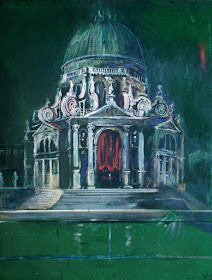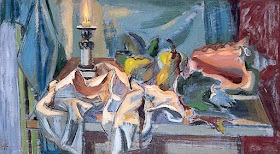 |
| Graham Sutherland Study of Rock and Flames 1975 oil on canvas National Museum Cardiff (Wales) |
 |
| Graham Sutherland Cathedral (Study of Rocks) ca. 1974-76 oil on canvas National Museum Cardiff (Wales) |
 |
| Graham Sutherland Fountain 1965 oil on canvas National Museum Cardiff (Wales) |
 |
| Graham Sutherland The Scales 1961-62 oil on canvas Tate Gallery |
 |
| Graham Sutherland Hanging Form over Water 1959 oil on canvas Southampton City Art Gallery |
 |
| Graham Sutherland Path through Woods ca. 1958 oil on canvas Southampton City Art Gallery |
 |
| Graham Sutherland The Honourable Edward Sackville-West 1957-58 oil on canvas Birmingham Museum and Art Gallery |
 |
| Graham Sutherland Santa Maria della Salute 1957 oil on canvas Southampton City Art Gallery |
 |
| Graham Sutherland Hydrant II 1954 oil on canvas Tate Gallery |
 |
| Graham Sutherland Standing Forms II 1952 oil on canvas Tate Gallery |
"Graham Sutherland was born in London. Though he initially worked as an engineer on the railway, he took up a place at Goldsmiths School of Art in 1921. Sutherland trained as an etcher at Goldsmiths, and only began painting in the 1930s. He was flexible in his use of medium: ranging from painting and stained glass to fabric work and printmaking. He taught many of these varied skills at the Chelsea School of Art. When that establishment closed, he moved to Gloucestershire and was offered a job as a salaried war artist. The paintings he did in this role were focused on the destruction of the Blitz, both in Wales and in London. He painted his first portrait in 1949. His most well-known portrait was that of Sir Winston Churchill, which was famously hated by Churchill and destroyed by Churchill's wife. In his later years Sutherland returned to Wales for inspiration and devoted much of his energy to printmaking."
– from biographical notes at Crane Kalman Gallery
 |
| Graham Sutherland The Origins of the Land 1950-51 oil on canvas Tate Gallery |
 |
| Graham Sutherland Study for The Origins of the Land 1950 graphite, bodycolour and crayon on board Courtauld Gallery, London |
 |
| Graham Sutherland Standing Form against a Hedge 1950 oil on canvas Southbank Centre, London |
 |
| Graham Sutherland Bird in Landscape 1944 oil on paper Manchester Art Gallery |
 |
| Graham Sutherland Horned Forms 1944 oil on panel Tate Gallery |












































